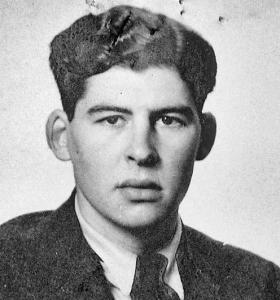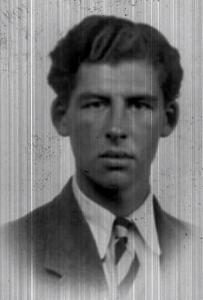
|

|
| First Officer Richard William PURSER | |
|
No. 6 Ferry Pilot Pool, Air Transport Auxiliary Date of birth: 5th September 1919 Date of death: 14th September 1941 Killed on active service aged 22 Buried at St Giles' Church, Stoke Poges |

|
| Richard William Purser was born at Slough on the 5th of September 1919 the second son of Thomas William Purser, a farmer, and Victoria Anne (nee Ruffell) Purser of Manor Close, Wraysbury in Buckinghamshire. He was educated at Lancing College where he was in Heads House from September 1933 to July 1936. He was a member of the Boxing Team in 1935. He went on to the University of Reading from where he graduated with a Diploma in Agriculture . He obtained his Aero Club Certificate (No. 19298) on the 27th of July 1939 at Exeter Aero Club flying a Miles Hawk, Gypsy Major 130. Following the outbreak of war he volunteered for service in the Royal Air Force on the 18th of September 1939. He was granted the rank of Acting Sergeant and was posted to Rhodesia for pilot training in May 1940. He served with them until the 7th of February 1941 when he failed his flying course, having accumulated 105 hours of solo flying time of which 11.05 hours were at night. He applied for a transfer to the Air Transport Auxiliary on the 18th of February 1941 and attended an interview two days later. At a medical examination, which took place on the 20th of February 1941, it was recorded that he was was six feet tall and that he had a medium complexion, hazel eyes and brown hair. He reported for duty on the 1st of April 1941 and was granted the rank of Second Officer. He was posted to the Training Pool on the 20th of June 1941 and completed his training course on the 12th of July 1941, having successfully flown and delivered four Hurricane and four Lysander aircraft. He was promoted to First Officer on the 11th of July 1941, being posted to No. 1 Ferry Pilot Pool, based at White Waltham from the same date. He was posted to No. 15 Ferry Pilot Pool, based at Hamble on the 3rd of August 1941 and on the 19th of August he became qualified to fly Spitfires. He was posted to No. 6 Ferry Pilot Pool, based at Ratcliffe on the 25th of August 1941. Richard Purser took off from Ratcliffe at 1.17pm on the 14th of September 1941 in Oxford Mk II X6958 for a ferry flight to RAF Burton Wood Repair Depot in Cheshire. At the outset of the flight he had 224.20 hours of total solo flying time of which 9.20 hour were on Oxford aircraft. The weather forecast was for 7/10th cloud with a base of 1,500 feet and with visibility of two to four miles. The aircraft crashed in bad visibility at Sandon Road Farm, Weston-on-Trent, some four miles from Stafford at 1.40pm. The farmer, Mr. Ronald Leonard Martin, was an eyewitness to the crash and was the first on the scene. He made the following statement: - "At about 1.30pm on Sunday the 14th September, 1941 I was standing in my farm yard when I saw an aeroplane flying in a northerly direction. It was flying in and out of the very low clouds. I saw it turn left and lose height, and it circled almost completely round, losing height all the time. It had then circled completely round until it was again approaching the farm from the south. It was then very low over the tree tops and I lost sight of it behind the farm buildings and immediately afterwards I heard it crash. As I lost sight of it, it was diving at an angle of about 45 degrees and I could see it would crash. The engine was full on. After the crash I saw bits of the plane flying past the end of the farm buildings. I ran to the scene and found the pilot lying across some barbed wire. He was still alive but unconscious. I pulled him off the wire and he died almost immediately." His body was taken to the mortuary at Stafford Police Station. An Inquiry was held into the accident at the Guidhall, Market Square, Bath Road, Stafford at 2.45pm on the 16th of September 1941 and was attended by a member of the Air Transport Auxiiliary. He wrote the following to his superiors in a letter dated the 16th of September 1941: - "Dear Sir, In accordance with the insructions of First Officer A. Kirkman Smith stationed at Ratcliffe aerodrome, near Leicester, I attended the Inquest on the above named, held at the Guildhall, Stafford. The deceased was killed in a flying accident when his plane crashed at Weston, mear Stafford at about 1.40pm on Sunday the 14th September 1941. The deceased was the only occupant of the plane. The Coroner was Mr. W. W. M. Morgan and the deceased was identified by First Officer A. K. Smith. Asked by the Coroner if he had any opinions as to what might have caused the accident, First Officer Smith expressed the opinion that the deceased was probably looking for somewhere to land and in doing so throttled back and stalled the machine and then raced the engine full out in an attempt to get out of the dive into which he got but was unable to do so in time. He explained that the deceased was ferrying the machine from Ratcliffe Aerodrome to Burton Wood Repairs, Warrington, and that the weather report before he set out was not good. First Officer Smith explained this to the deceased but he prefered to so and went with the full knowledge that the weather was not good. The machine was a Flying Oxford Mark II 6958 and the deceased was a pilot fully qualified to pilot this type of machine and the machine itself had been inspected that morning as was the usual procedure. The deceased had flown the same machine that morning. Evidence was also given by two witnesses who saw the ceash, namely, Ronald Leonard Martin, a farmer of Weston and Arthur Rook of Gayton, near Stafford, a member of the Royal Observer Corps who was on duty at the time. Both eyewitnesses |
|
 | |
| Heads House |
Back